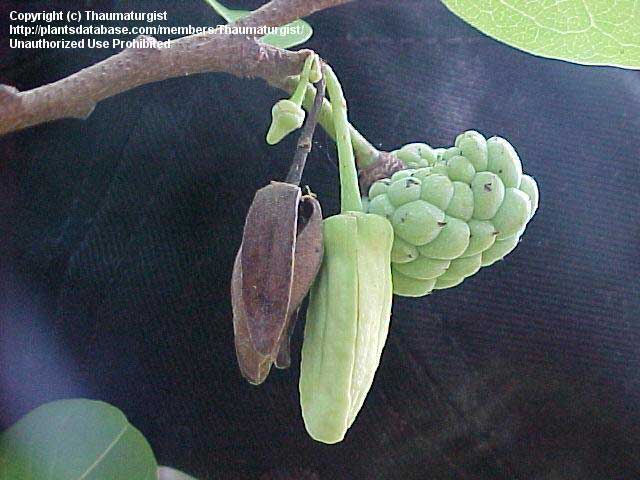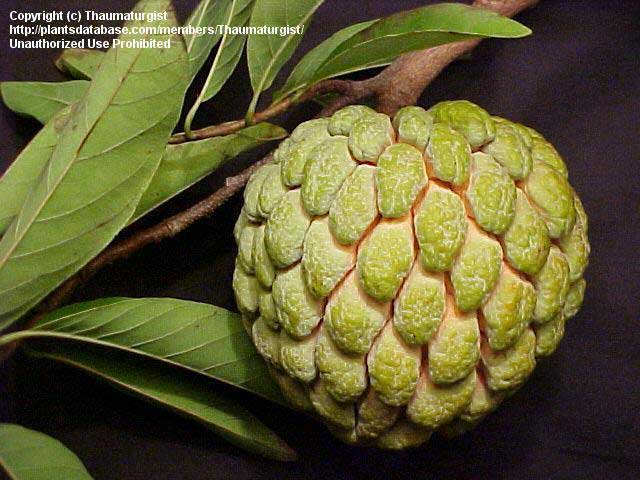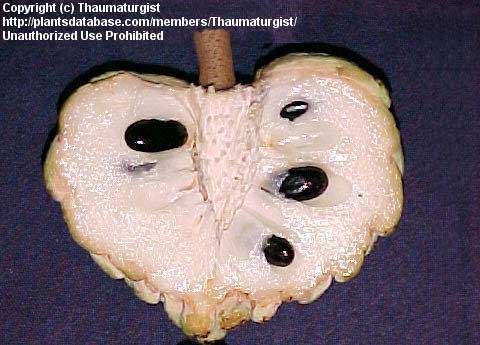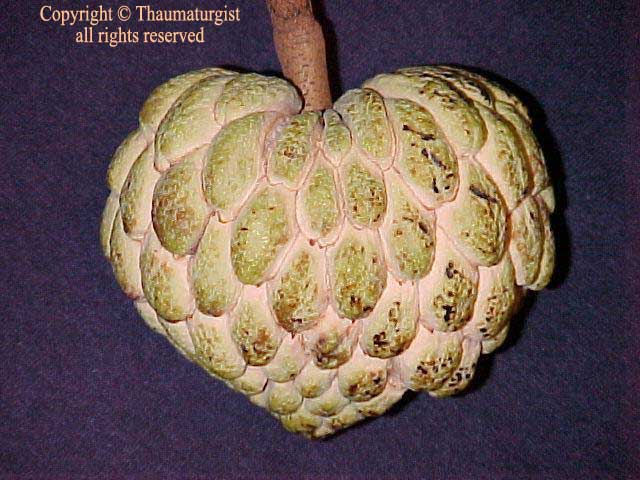The Sugar Apple
Annona squamosa is a small deciduous tree that only reaches a height in
Florida of about 20 to 25 feet. Native to Central America this grows best
in warm frost free areas. The leaves are alternate, 6-8 inches long and thin,
and the tree loses those leaves shortly after Christmas and is bare for
about four to six weeks. Flowers appear with the leaves in the spring and
the fruit ripens starting in mid to late summer through late fall.
Fruits are anywhere from 3 to 5 inches in diameter with a lumpy green skin and upon maturity the fruit has a bluish or white blush. Some varieties are developed that have a red blush or red skin which are much more attractive. At maturity fruits have a custard like white pulp with small black seeds and the sweet flesh is eaten fresh or used for milkshakes and ice creams. During wet summers often maturing fruit tends to split and this can be prevented by picking the fruits just prior to full maturity and ripening them off the tree.
Trees are easily started from seed and it takes one to two years for seedlings to start producing flowers. Many superior varieties are available and these are sold through nurseries as grafted or budded plants. Trees have few problems other than cold weather, but the fruit is attacked by annona seed borer and occasionally caterpillars might chew foliage.
Fruits, once mature, can be cleaned and the pulp frozen for many months for future use. If close to salt water, protect sugar apples from direct ocean spray since this may cause burning of the thin leaves. Some varieties to look for include Island Gem, Lincoln, Cuban, Brazilian and Purple.
Sugar apples make great container plants, too, so if you don't have much space try growing these in a 10 or 15 gallon tub, and they will still reward you with a number of delicious fruit.
Trees in the landscape should be fertilized every three to four months with a citrus or palm type fertilizer containing good levels of micro-nutrients. In highly alkaline soil deficiencies may develop that require nutritional sprays to correct.
Fruits are anywhere from 3 to 5 inches in diameter with a lumpy green skin and upon maturity the fruit has a bluish or white blush. Some varieties are developed that have a red blush or red skin which are much more attractive. At maturity fruits have a custard like white pulp with small black seeds and the sweet flesh is eaten fresh or used for milkshakes and ice creams. During wet summers often maturing fruit tends to split and this can be prevented by picking the fruits just prior to full maturity and ripening them off the tree.
Trees are easily started from seed and it takes one to two years for seedlings to start producing flowers. Many superior varieties are available and these are sold through nurseries as grafted or budded plants. Trees have few problems other than cold weather, but the fruit is attacked by annona seed borer and occasionally caterpillars might chew foliage.
Fruits, once mature, can be cleaned and the pulp frozen for many months for future use. If close to salt water, protect sugar apples from direct ocean spray since this may cause burning of the thin leaves. Some varieties to look for include Island Gem, Lincoln, Cuban, Brazilian and Purple.
Sugar apples make great container plants, too, so if you don't have much space try growing these in a 10 or 15 gallon tub, and they will still reward you with a number of delicious fruit.
Trees in the landscape should be fertilized every three to four months with a citrus or palm type fertilizer containing good levels of micro-nutrients. In highly alkaline soil deficiencies may develop that require nutritional sprays to correct.

Flowers and young fruit

Ripe, ready to pick
One of the fruits I grew up
with was a sugar apple which might explain my love of this fruit. In the
intervening years I learned much about the plant and its several varieties.
With the occasional chills in Florida the sugar apple can be deciduous most of the winter.
Sugar apple was crossed with the Cherimoya to produce the Atemoya, a tasty, gritless hybrid.
When tasted all good varieties are about equal though there is some variation in size and colour. Not surprisingly the red and purple forms have the most appeal, but I doubt many could tell the difference in the dark.
I have traced the three Florida forms of purple/red fruits to three introductions. Only a genetic study can verify that they are separate varieties. Red/purple varieties are Kampong Mauve, Smathers and Whitman purple.
There is discussion as to what percent of seeds from a purple fruit will produce purple fruit when grown. It may be that crossing with green forms is to blame. Seedlings from good fruit usually produce good fruit, whatever the colour.
As a container plant the sugar apple can reward a grower with fruit when barely 3 feet tall and still in a 5 gallon container and is an excellent addition to any collection.
Some people complain about the fruit's grittyness but this is not a real problem. The seed borer seems to be on the rise in Florida which may pose problems in the future.
With the occasional chills in Florida the sugar apple can be deciduous most of the winter.
Sugar apple was crossed with the Cherimoya to produce the Atemoya, a tasty, gritless hybrid.
When tasted all good varieties are about equal though there is some variation in size and colour. Not surprisingly the red and purple forms have the most appeal, but I doubt many could tell the difference in the dark.
I have traced the three Florida forms of purple/red fruits to three introductions. Only a genetic study can verify that they are separate varieties. Red/purple varieties are Kampong Mauve, Smathers and Whitman purple.
There is discussion as to what percent of seeds from a purple fruit will produce purple fruit when grown. It may be that crossing with green forms is to blame. Seedlings from good fruit usually produce good fruit, whatever the colour.
As a container plant the sugar apple can reward a grower with fruit when barely 3 feet tall and still in a 5 gallon container and is an excellent addition to any collection.
Some people complain about the fruit's grittyness but this is not a real problem. The seed borer seems to be on the rise in Florida which may pose problems in the future.
Editor

Ready to eat
